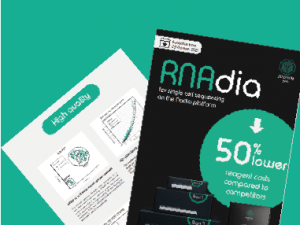Dolomite Bio’s latest webinar, introducing the RNAdia kit, alongside some interesting research
We recently announced the launch of our novel RNAdia kit for high-throughput single cell profiling. At 50% of the cost of competitor reagents, RNAdia allows researchers to do more projects within their budget.
To introduce this exciting new development, we hosted a webinar in collaboration with Illumina, featuring guest speaker Dr. Chris Sibley. In the webinar we explored the details of the RNAdia kit and the use of our Nadia Instrument for single cell RNA Sequencing, alongside Illumina’s latest news and portfolio advancements. Dr. Chris Sibley also presented his latest research on the results of studying phased transcriptional regulators of cell cycles with scRNA-Seq.
Jump straight to our digest of Dr. Chris Sibley’s presentation.
The details
Title: An introduction to Dolomite Bio’s RNAdia kit – Elucidating phased transcriptional regulators of cell cycle with scRNA-Seq
Speakers:

What did we learn?
The possibilities of scRNA-Seq research and relevant research areas
The webinar began with the conditions and research areas where high throughput single cell profiling is relevant. Single cell profiling is a useful tool for many research applications such as understanding cell heterogeneity, cellular gene expression during normal and disease states, drug development, and personalized medicine.
The benefits of the Nadia platform and RNAdia kit
There are several features and benefits of the Nadia platform for researchers who are exploring their single cell sequencing platform options. Dolomite Bio’s fully automated, cost-effective, and high throughput instrument for the encapsulation of single cells within droplets, encapsulates up to 8 samples, in parallel, in under 20 mins. Over 50,000 single cells can be captured per cartridge in a run. The fully automated Nadia Instrument guides users through all relevant steps of the experiment via an easy-to-use touchscreen interface.
The new RNAdia kit encompasses all the reagents required to perform single cell RNA-Sequencing on the Nadia. Including emulsion breakage, cDNA synthesis, PCR (Polymerase Chain Reaction) amplification, NGS (Next Generation Sequencing) library synthesis, and data analysis and visualisation (add-on). This kit enables the users to conduct gene analysis at half the cost of competitor reagents.
You can read our full blog introducing the RNAdia kit here
RNAdia data – mouse and human cell lines
In-house high-quality data obtained from the RNAdia kit using both mouse and human cell lines was presented. A high gene capture rate, low doublet rate, and the visualization of distinct cell clusters for each species could be seen.
Illumina NGS platforms
The webinar included an excellent talk from, Dr. Pawel Zajac, explaining the compatibility of the Illumina NGS platforms within the single cell RNA-Sequencing workflows. As well as Illumina’s latest advancements, including a range of instruments designed for both small- and large-scale sequencing.
Illumina and RNAdia on the Nadia Instrument compatibility
The RNAdia kit allows for the construction of sequencing ready libraries. Those libraries are compatible with standard NGS short-read sequencing on Illumina sequencers, allowing to analyse thousands of transcriptional profiles of single cells in parallel. (Note, cDNA libraries from Nadia are sequencing platform agnostic and can be used for long-read sequencing on Pacific Biosciences or Oxford Nanopore sequencers.)
Dr. Chris Sibley’s experience with the Nadia platform
Dr. Chris Sibley is a group leader and Welcome Trust Sir Henry Dale fellow at Edinburgh University. His research focuses on understanding the cause and consequence of RNA metabolism changes in neurological diseases such as ALS, and his team have been applying single cell technologies to chronicle these changes directly in clinically relevant stem cell models and human tissues.
Why they chose the droplet methods and the Nadia platform
The Nadia platform’s droplet approach was of particular interest of Dr. Sibley and his team as droplet technology has the ability to capture mammalian cell lines at high throughput, where thousands of cells can be captured, in a short period of time.
This was complimented by the features of the Nadia Innovate, such as the ability to control pressure and temperature. Accurate control of droplet dimension proved critical in enhancing the mRNA capture rates in Dr. Sibley’s research. The additional benefit of the reagent flexibility with the Nadia platform, meant that another crucial aspect was the ability to use different buffers.
Data quality of their single cell and single nuclei sequencing experiments
During his time using the Nadia Platform for both single cell and single nuclei RNA-Sequencing (sNuc-seq), Dr.Sibley experienced a low doublet ratio, a clear separation of different cell types, large sequencing information, and a high of gene capture rate. In comparison to previously published data, he obtained a greater RNA capture rate at low read depths when conducting our sNuc-seq workflow.

Dr. Sibley’s research on transcriptional regulatory networks
Recently, Dr. Sibley set out to elucidate the transcriptional regulatory networks of cell cycle genes. Using the single cell RNA-Sequencing data acquired from the Nadia platform with human fibroblasts, he found 72 known transcriptional factors with phased activity throughout the cell cycle, validated the expression of known cell cycle regulators and discovered 7 novel transcriptional factors, some of which have been previously linked with dysregulated cancers. The novel transcriptional factors identified through the workflow performed on the Nadia platform were further investigated in their role within dysregulated cancers.
Questions from the webinar audience
Skip to the conclusion and further reading?
General single cell sequencing questions
Q: What are the limiting factors for obtaining genes per cell?
A: There is a number of different factors such as type of protocol, quality of samples, sample type, ability to capture mRNA, and sequencing depth.
Q: Does the gene size matter?
A: Gene size might have an influence for particular protocols such as sNuc-seq as amplifying the full transcript will require a template switching mechanism. However this can be challenging with the extremely long pre-mRNAs and therefore reverse transcription might not always be complete.
Nadia Platform and RNAdia questions
Q: What is the difference between the Nadia and the Innovate?
A: The Nadia instrument was developed to enable the standard applications provided by Dolomite Bio such as single cell and single nuclei RNA-Sequencing. The instrument itself guides you through the processing of a sample based on the application. The Nadia Innovate is an add-on to the Nadia Instrument which has several customisable parameters, such as the pressure, time, temperature, and stirrer speeds, for the users to optimize a workflow to suit their samples. The Nadia Innovate only enables one sample run so once these parameters have been optimized, the workflow can be transferred to the Nadia to run up to 8 samples to be processed at once.
Q: Can you use the Nadia and Innovate platforms to processed fixed samples?
A: Yes. However, the fixed samples should undergo single nucleus instead of single cell RNA-Sequencing.
Q: Is there a comparison of the RNAdia kit to the previous workflows?
A: The RNAdia kit gene capture rate is similar to previous workflows but the main difference is making the protocol simpler, more convenient, with higher quality reagents, and at a lower cost (50% cost save compared to other commercial platforms).
Illumina Q&A
Q: What can you sequence on the Illumina NextSeq 2000?
A: The NextSeq 1000 and 2000 can sequence anything as long as you add a library preparation that has the correct adapter. It is a flexible system for all types of applications.
Q: What Illumina platforms are used for single cell RNA-Sequencing
A: Majority of the work done for single cell RNA-Sequencing is on the NextSeq or NovaSeq platforms as they provide high intensity sequencing.
Q: What is the difference between the Illumina’s NextSeq 1000 and 2000?
A: The difference between these two platforms is which flow cells you can run. There are three flow cells: P1 (100 million reads), P2 (400 million reads), P3 (1.2 billion reads). With the NextSeq 200, you can run all 3 flow cells but with the NextSeq 1000 , you can run only the P1 and P2 flow cells.
Q: When will Illumina’s P1 flow cell be launched?
A: The P1 flow cell is available on Ilumnia’s Website.
Questions for Dr. Sibley
Q: Did you check the nuclei capture rate in real-time or after treatment?
A: Nuclei capture could not be seen in real time originally but Dr.Sibley’s team replaced the lysis buffer in the cell buffer with a DAPI stain to visualize the nuclei encapsulation process.
Key takeaways
– The Nadia Platform is a droplet-based approach to single cell RNA-Sequencing
– Droplet-based approaches enable high throughput encapsulation of single cells in a short period of time
– Dolomite Bio have launched the new RNAdia kit that encompasses all the reagents for a complete single cell RNA-Sequencing workflow at low cost
– Dr. Sibley has used the Nadia platform to capture both single cells and single nuclei in droplets and has obtained a higher gene capture rate than in previously published data.
– Recently, Dr. Sibley has used the Nadia platform to advance his research into understanding the transcriptional regulation of the cell cycle and has identified novel cell cycle transcriptional factors.
 Watch the full webinar recording
Watch the full webinar recording



